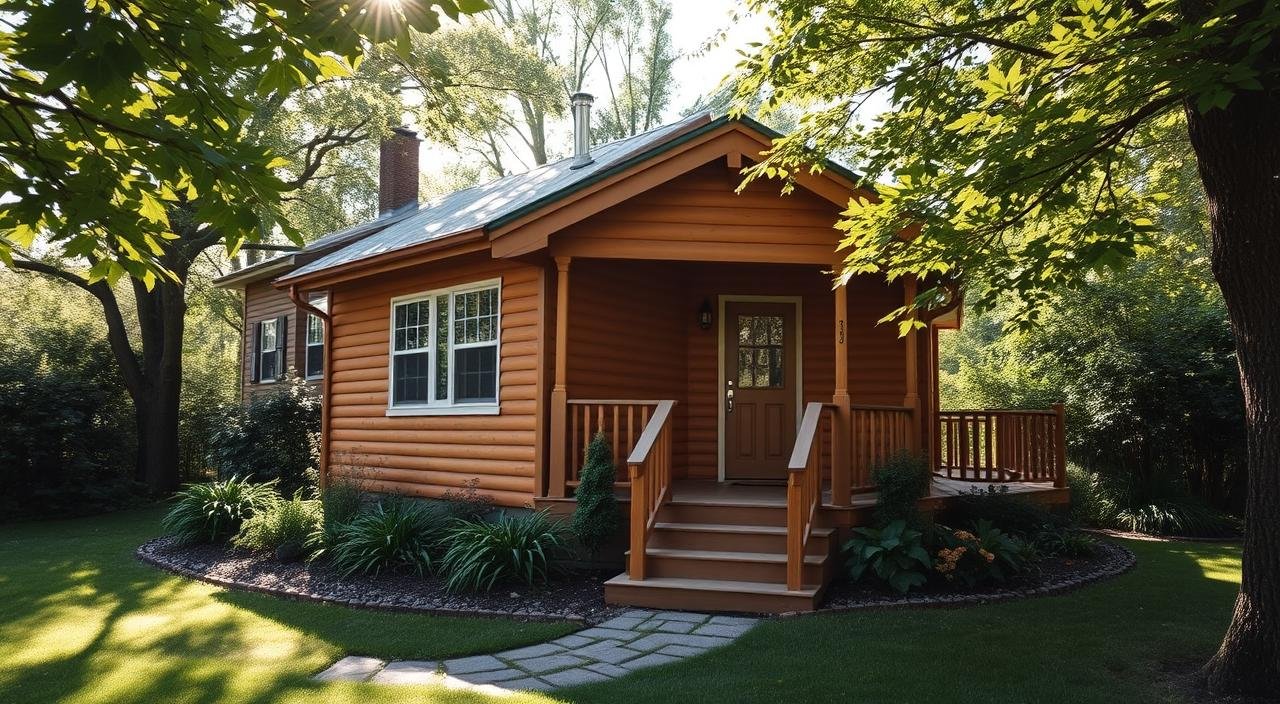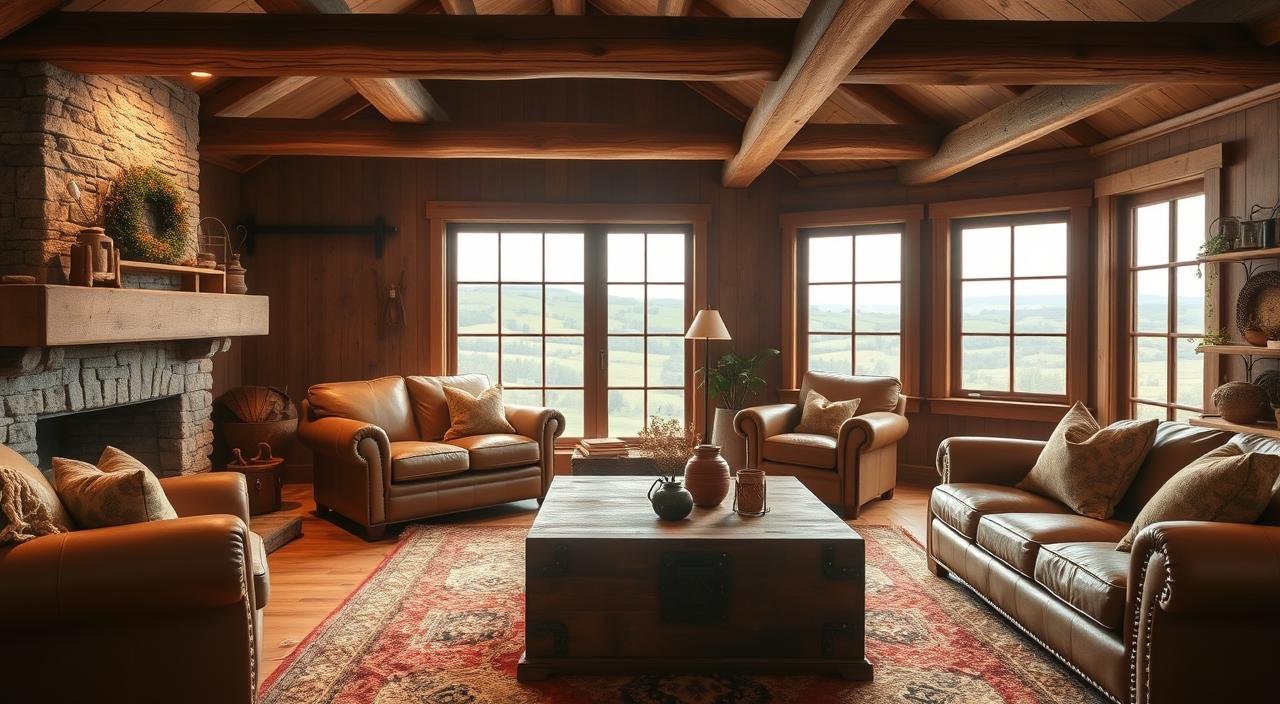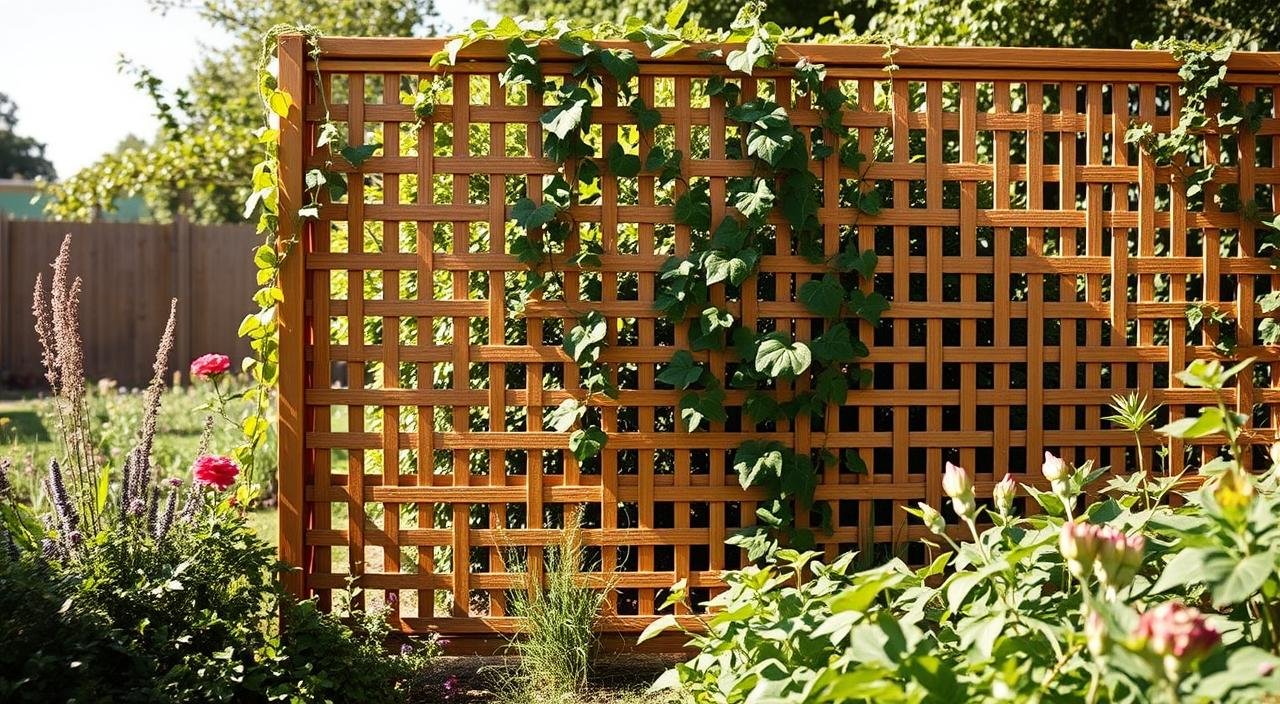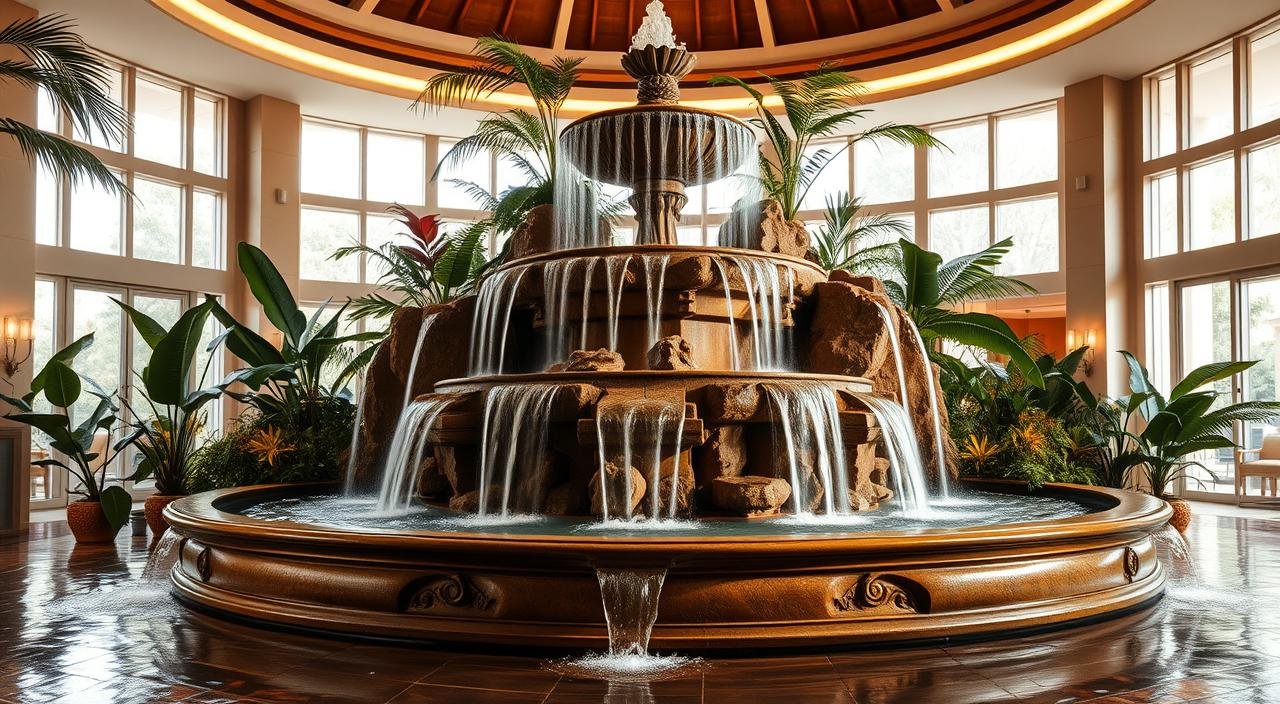I’ll Show You Small House Exterior Design Ideas That Wow
Ever ponder how a tiny home can outshine its larger neighbors? It’s not about size; it’s about making smart choices. I’ve transformed numerous compact homes into neighborhood gems. Today, I’ll share secrets to turn 1,000-square feet into a work of art.
Think your tiny home must blend in unnoticed? Think again. The latest trends show that modern farmhouse lines or brick ranch details can instantly boost curb appeal. My clients in Austin transformed a 900-square-foot bungalow into a standout with just a few strategic updates. No need for a full gut job.
Every decision counts in small house design. A dark wood front door contrasts beautifully with earth tones, drawing the eye. Streamlined roofs and copper accents add a touch of luxury without adding bulk. Even Victorian-inspired arched windows can fit into tight spaces when scaled correctly. This guide will take you through materials like Brava Roof Tile’s cedar shakes and affordable color pairings that elevate small spaces to sophistication.
Key Takeaways
- Small exteriors thrive with bold focal points like gas lanterns or round windows
- Modern farmhouse and brick ranch styles work wonders for compact homes
- Copper and terracotta accents add luxury without costing a fortune
- Streamlined roofs and mitered siding maximize visual impact
- Color psychology tricks make spaces feel larger and cozier
Why Small House Exterior Design Matters More Than Ever
Think your home’s exterior is just a facade? Think again. Your small house exterior design isn’t just about looks—it’s your first line of emotional connection and financial opportunity. Let’s dive into why investing here changes everything.
The Psychological Impact of Coming Home to Beauty
“These renderings nearly made me cry”—this wasn’t a client’s first reaction to a renovation. It’s proof that beautiful exteriors touch us deeply. Imagine pulling up to a home where every detail feels intentional. That’s the power of design. My clients often share how a fresh paint job or a blooming garden transforms their mood instantly. Science backs this: studies show well-designed spaces reduce stress and boost pride. Your home isn’t just a place—it’s a mood-lifter and sanctuary.
How Exterior Design Affects Property Value
Numbers don’t lie. A 2023 report shows curb appeal upgrades recoup 150% of costs at resale. Let’s break it down:
Material Lifespan ROI Boost Metal Siding 40–70 years +18% Synthetic Slate Roofing 50 years +12% Wood Composite 30+ years +9% Materials that last and look great? That’s smart spending. Vertical siding? It tricks the eye into seeing height. Black window frames? Modern flair with function. These choices aren’t just pretty—they’re investments.
First Impressions: The Power of Curb Appeal
In a world of online listings, your tiny home curb appeal is your first sales pitch. Buyers scroll fast—80% form opinions in 10 seconds. A well-landscaped walkway or a porch with string lights? They’re your silent salespeople. Even tiny homes can shine: bold colors like deep navy or two-tone paint schemes make small spaces pop. This isn’t just style—it’s strategy.
Ready to turn your curb into a confidence booster? Let’s talk details that matter.
The Fundamentals of Small House Exterior Design
Ever ponder how to elevate a modest home into a design masterpiece? Let’s dive into the basics. Great small house exterior design hinges on balance, akin to a perfectly balanced painting. Scale is critical: oversized shutters or mismatched accents can overwhelm a small facade. Ensure elements like door height, window spacing, and trim sizes align to prevent a cluttered appearance. A front door that’s two-thirds the wall’s width can bring visual stability.
- Match architectural details: Craftsman homes benefit from Mission-style accents; Victorian styles love detailed trim.
- Follow lighting ratios: Pendant lights should be 1/5th your door’s height—no guesswork!
- Pick compact house exterior ideas like vertical shutters or slim-line railings to maximize visual space.
Simplicity is not about emptiness—it’s about focused strategy. Choose one standout feature (a bold front door, a patterned accent wall) and let it be the focal point. Overdecorating dilutes the impact. Tools like James Hardie fiber cement siding offer durability with style, while Hover® Design Studio allows virtual testing before commitment.
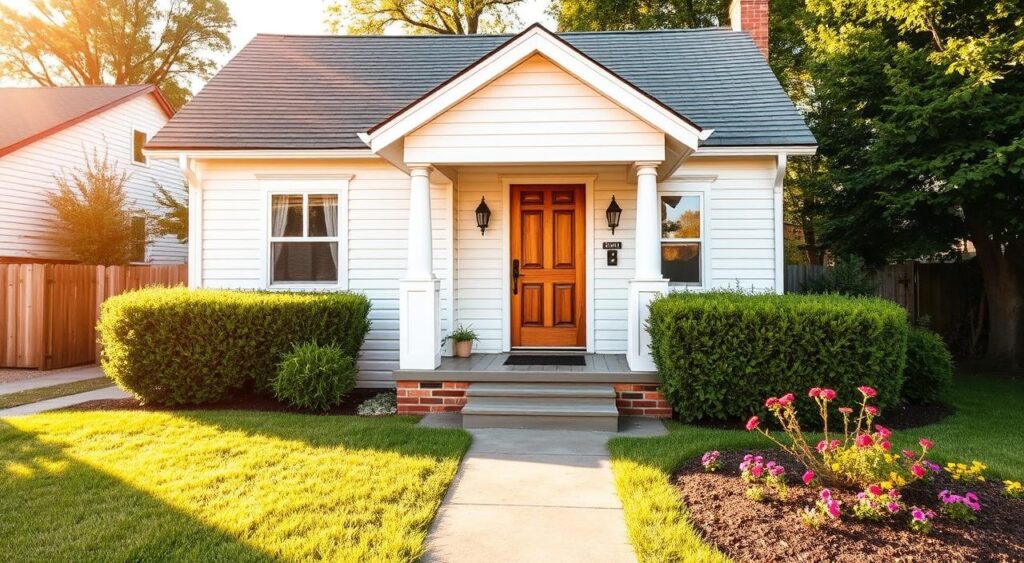
Remember, cohesion is essential. Every element, from porch railings to mailbox style, should speak the same design language. When colors, materials, textures, and scale align, even an 800 sq ft home exudes intention. Ready to transform your space into a statement? These fundamentals are your guide.
Modern Small House Facade Trends for 2023
Ready to give your small home a style refresh that turns heads? Let’s dive into what’s trending in modern small house facade design this year. From bold materials to smart layouts, these ideas prove that less space doesn’t mean less wow.
Let’s start with the materials making waves right now. Contemporary materials are all about faking luxury affordably—think James Hardie siding in Iron Gray or Benjamin Moore’s Seapearl trim. Mix and match textures: try stucco walls with cedar accents or vinyl siding paired with stone veneer. A pro tip? “Natural wood accents are a game-changer,” says architect Sarah Lee. “They add warmth without overwhelming small spaces.”
- James Hardie fiber cement for low-maintenance charm
- Benjamin Moore’s Black on eaves for bold contrast
- Breeze block walls for privacy and pattern
Innovative structural elements turn tiny facades into architectural gems. Stacked windows, like transom setups, flood rooms with light while adding vertical interest. Cantilevered porches or asymmetrical roofs trick the eye into seeing more space. Pro move: cable-and-wood railings frame entries with modern flair.
Want compact house exterior ideas that feel intentional? Balance clean lines with personality. Pair chunky Craftsman trim with a pop of Wasabi green shutters. Use texture layers—like brick + vinyl or metal + wood—to add depth without clutter. Color blocking (think white walls with navy soffits) creates drama without overcomplicating the layout.
“Mixing materials contrasts is key. A little texture goes a long way.” –住宅設計専門誌, 2023
Ready to reimagine your facade? These trends prove that even 1,000 sq ft can look like a luxury retreat. Let’s make your modern small house facade stand out—without breaking the bank!
Maximizing Curb Appeal When Space is Limited
Small homes can rival grand estates in curb appeal. Every tiny home has hidden beauty waiting to be unleashed. Let’s turn those “I wish I’d done this sooner” moments into reality.
“The extra overhang + pillars are gone from the garage. This wasn’t even a structural change—just a rip off. And I’m left wondering—why have we left it there this long? It looks so much better!” – Homeowner’s Honest Take
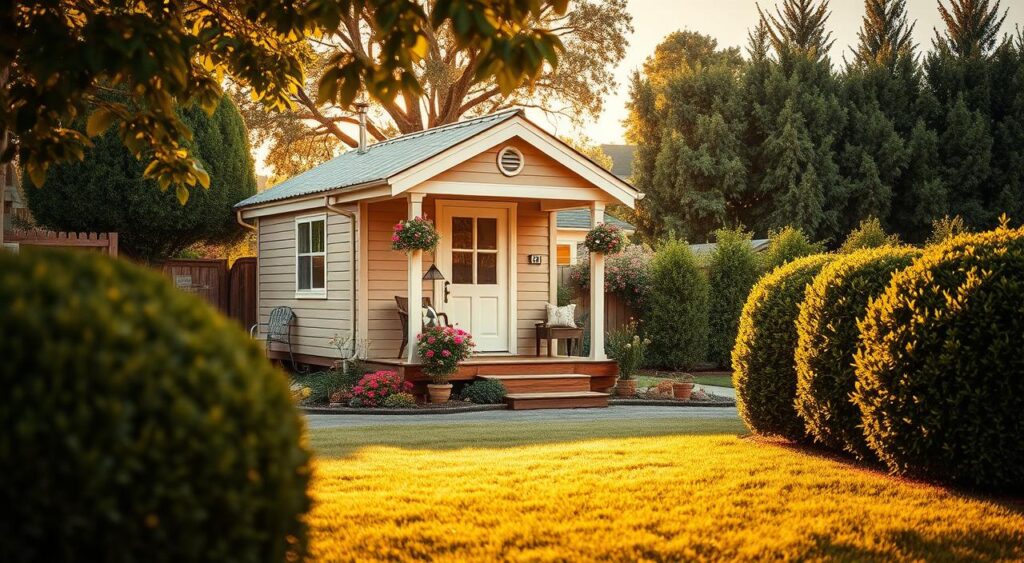
Focal Point Strategies for Tiny Home Curb Appeal
Draw eyes upward with vertical elements:
- Install a bold front door in red or navy—think “wow” without widening the walls.
- Add a lantern-style porch light or a trellis with climbing roses to anchor the entrance.
- Use oversized potted plants or a minimalist water feature as a visual magnet.
Using Scale and Proportion to Your Advantage
Balance is key. Avoid tiny planters next to a 12-foot oak tree—here’s how:
- Pick fixtures proportionate to your home’s size (a 24-inch doormat for a 1,000 sq. ft. home).
- Layer window boxes in ascending sizes to guide the eye smoothly.
- Stick to 2-3 accent colors max to avoid overwhelming the facade.
Visual Tricks That Make Small Houses Look Larger
Architects use these pro secrets:
- Vertical lines like tall metal planters stands or slim trellises create height illusions.
- Paint the home’s trim a shade lighter than the walls to create depth.
- Use a checkerboard walkway pattern or striped pavers to draw the eye forward.
Remember: Less can mean more. Every tiny home deserves to feel like a masterpiece. Start small, think bold, and watch your small house exterior design transform overnight.
Color Psychology: Choosing the Perfect Small House Exterior Color Schemes
Ever pondered how colors can turn a small house into a standout home? Let’s explore the science behind small house exterior color schemes that truly work. Begin by asking: What mood do you wish your small house exterior design to convey?
Consider painting brick homes white to create striking contrast—a strategy builders employ to update older structures. Warm hues like terracotta or burnt orange bring a sense of warmth, while cool blues and grays can make spaces appear larger. Adhere to the 60/30/10 rule: 60% light neutrals (walls), 30% medium tones (shutters, trim), and 10% bold accents (doors, pots). This approach prevents small spaces from feeling overwhelmed.
| Color Family | Emotion | Best For |
|---|---|---|
| Warm colors (red, yellow) | Energy, friendliness | Front doors, accent walls |
| Cool colors (blue, green) | Calmness, spaciousness | Main walls, roof accents |
| Neutral bases (white, gray) | Timelessness | Facades needing flexibility |
Steer clear of clashing accent colors—opt for 2-3 hues at most. Test samples on your home at sunrise, noon, and sunset. Benjamin Moore’s “Alabaster” or Sherwin-Williams’ “Oxford White” complement wood tones well. Remember, your color choices should mirror your personality while boosting curb appeal. Are you ready to paint your masterpiece?
Budget-Friendly Small House Landscaping Ideas
Landscaping is your secret weapon for boosting tiny home curb appeal without overspending. With smart choices, even a modest budget can turn your yard into a showstopper. Let’s dive into three actionable steps that deliver big results.
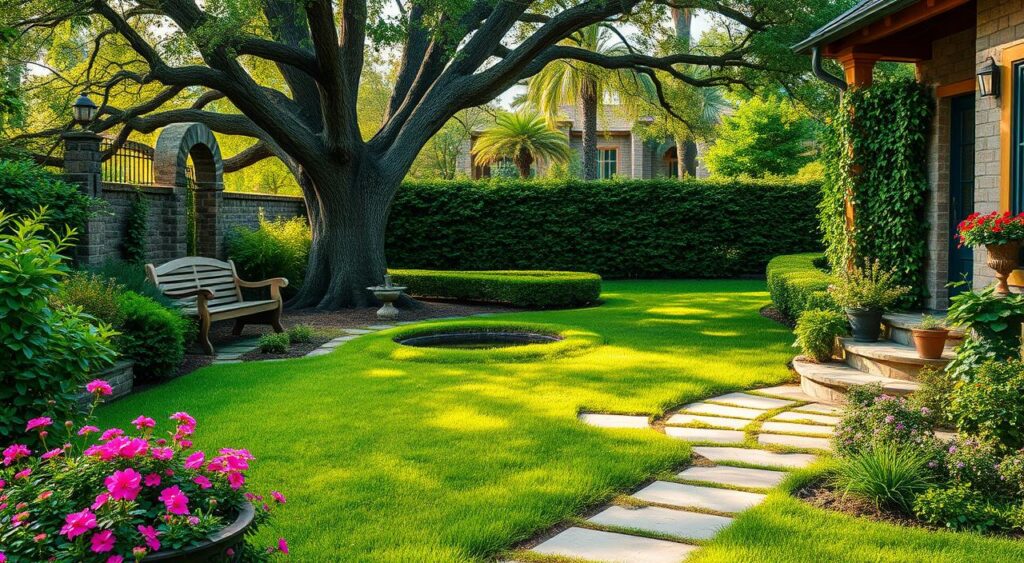
Low-Maintenance Plants That Make a Big Impact
Choose plants that thrive with minimal effort. Perennials like sedum, lavender, and black-eyed susans come back every year, saving you time and money. For texture, try river rocks or stacked stone borders—they add drama without requiring water or pruning. Here’s your starter list:
- Sedum ‘Autumn Joy’ – drought-tolerant, blooms all season
- Boxwood shrubs – classic structure with annual pruning
- Variegated hosta – bold foliage for shady spots
DIY Landscaping Projects for Weekend Warriors
Roll up your sleeves! These projects cost under $100 but make a huge difference:
- Gravel pathways – use pea gravel ($2–3/bag) for instant definition
- Vertical planters – PVC pipes or corrugated plastic create green walls
- DIY stepping stones – concrete mix ($5–10) with embedded river rocks
Smart Hardscaping Solutions for Limited Budgets
Tables speak louder than words. Compare these cost-effective hardscaping options:
| Material | Cost Range | Key Benefits |
|---|---|---|
| Gravel paths | $0.50–$1.50/sqft | Easy installation, weed suppression |
| Concrete blocks | $2–$5 each | Perfect for raised beds or seating |
| Recycled wood | $0 (free materials)–$10/ft | Customizable garden borders |
Remember: curves guide the eye, and vertical space is your ally. Start small—transforming one corner at a time builds momentum. Your tiny home’s curb appeal grows with every smart choice!
Small House Porch Design: Creating an Inviting Entrance
Your porch is the first impression your home gives to the world. It’s not about size, but about the intention behind it. A well-designed entryway can elevate your tiny home’s curb appeal, making even a small space feel welcoming. Let’s explore smart ways to add charm without losing practicality.
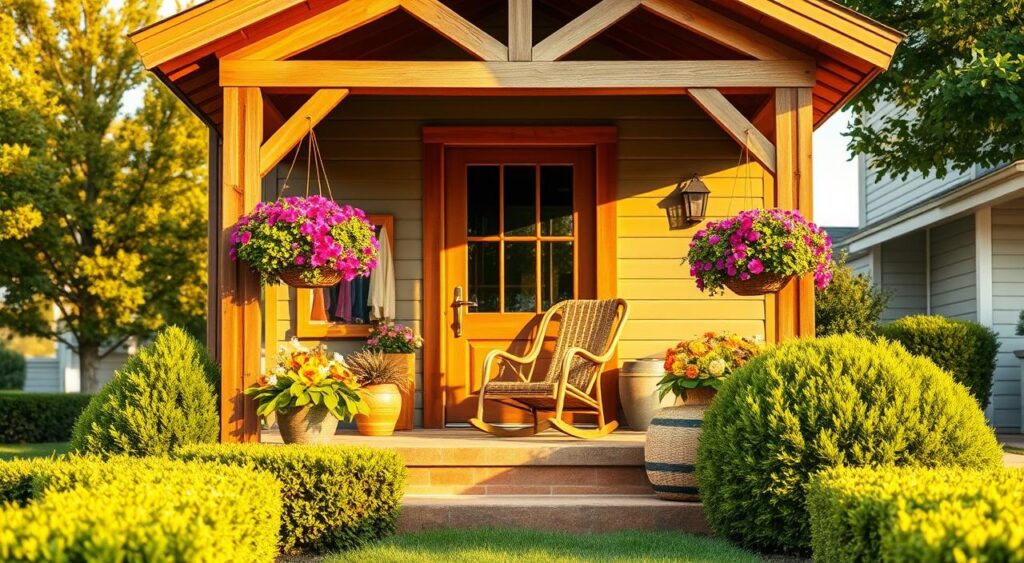
Begin with symmetry. Place matching Adirondack chairs or planters on either side of your door. This creates instant balance. Mix materials like weathered wood benches with sleek metal railings for contrast. Even a small porch can look grand with vertical elements, such as a wall-mounted succulent garden or a trellis for vines. Remember, painting your front door a bold color like cobalt blue can make the space feel larger.
- Use Chippendale-style railings for elegance without bulk
- Add solar-powered string lights for evening ambiance
- Choose a 30”x48” outdoor rug to anchor seating areas
- Mount a small hanging planter above a bench to add greenery
“The porch’s barrel vault got streamlined! A few sentimental touches—the hanging gas lanterns on the porch…”
Scale is key. Choose a petite Adirondack chair (24” wide) over oversized furniture. Layer textiles like a striped throw over a bench and add a weather-resistant cushion. For safety and style, install LED step lights along stair edges. Even a minimalist design gains warmth with a galvanized metal planter holding seasonal blooms. Every detail, from the doormat’s fringe to the railing’s finish, adds to the “wow” factor visitors notice.
Ready to transform your entryway? Focus on vertical space, balanced decor, and intentional color choices. Your porch is more than a doorway; it’s the first chapter of your home’s story. Let’s make it unforgettable.
Lighting Your Small House Exterior for Drama and Security
Picture your small house exterior radiating with an inviting glow, blending security with style. Lighting transcends mere functionality, becoming the crowning feature that boosts curb appeal and ensures safety. Let’s explore how thoughtful selections can transform your compact house exterior into a nighttime spectacle.
“The right fixtures can make your home feel like a New Orleans gem—even if you’re not in Louisiana!”
Begin with energy-efficient options that are budget-friendly: LEDs from Philips and GE reduce energy consumption by 80% while replicating the warmth of incandescent bulbs. Solar path lights from Keter or low-voltage systems from Hinkley Lighting offer a modern aesthetic without the financial strain. For inspiration, explore modern residential trends.
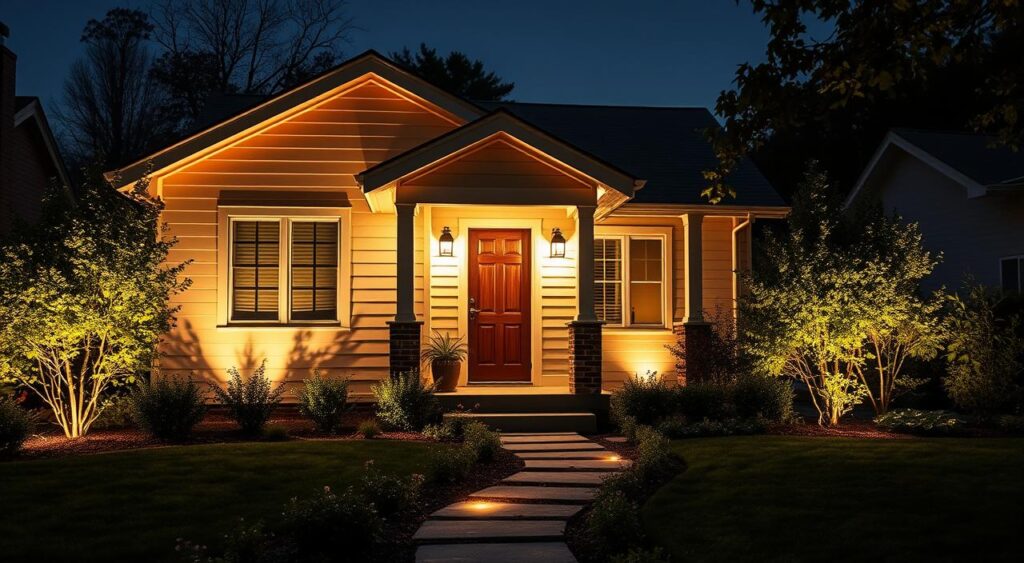
Next, strategic placement is key. Utilize this guide to accentuate your home’s most striking features:
| Fixture | Use | Tip |
|---|---|---|
| Uplighting | Architectural details | Position 6-8” from base for dramatic shadows |
| Path lights | Walkways & stairs | Space 3-5 feet apart for even coverage |
| Wall sconces | Doorways & walls | Mount 60-72” high for eye-level impact |
Seasonal adjustments keep your compact house exterior looking fresh. For winter, install motion-sensor path lights (such as Larson Electronics’ models) for added security. In summer, adorn arbors with solar-powered twinkle lights. Always ensure a layered lighting approach to maintain a welcoming ambiance throughout the year.
Minimalist Small House Front Yard Concepts
Imagine a front yard that exudes calmness, intention, and a sense of polish—that’s the essence of minimalist design. In a space-constrained environment, simplicity reigns supreme. A minimalist small house front yard is characterized by clean lines, deliberate details, and materials that convey elegance without excess. You don’t need expansive gardens or cluttered decorations to make a bold statement.
There’s something incredibly confident about a carefully edited front yard!
Begin by selecting one or two standout materials. Combine weathered wood siding with sleek stone accents, such as pairing board-and-batten walls with stone bases. Repetition of textures, like gravel pathways mirroring concrete pavers, creates harmony. Even a simple iron bench or a singular sculptural tree can become a focal point in this minimalist style.
Choose plants wisely. Opt for evergreens for year-round structure, drought-tolerant grasses for movement, or a single bold shrub in a sleek black planter. Native plants reduce maintenance while aligning with your region’s climate. For color, a single vibrant blooming bush has more impact than numerous smaller ones.
- Use neutral tones: whites, grays, and earthy tones with one bold accent color.
- Add drama with lighting: uplights under eaves or a single spotlight on a focal boulder.
- Let materials guide the vibe: Corten steel planters + river rocks = instant modern Zen.
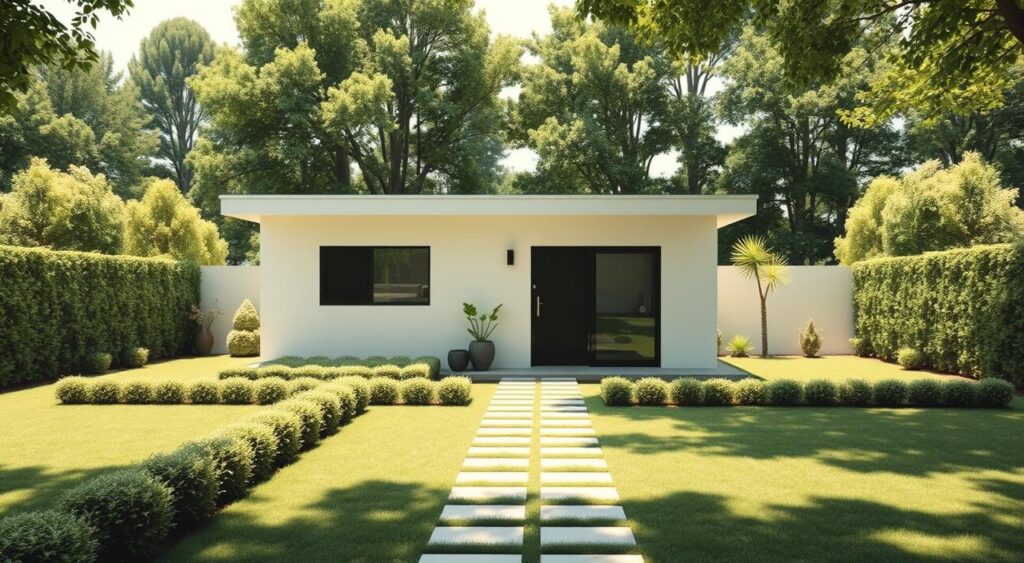
Small house exterior design doesn’t mean sacrificing beauty. A minimalist approach highlights your home’s architecture while saving time and money. Replace busy flowerbeds with a clean gravel path flanked by two sculptural boulders. Opt for cohesion over clutter—every element should enhance both function and aesthetics.
Ready to embrace the art of editing? A minimalist front yard is not empty—it’s meticulously curated. Begin by asking: “Does this element add value or just bulk?”
Weather-Resistant Materials for Different US Climate Zones
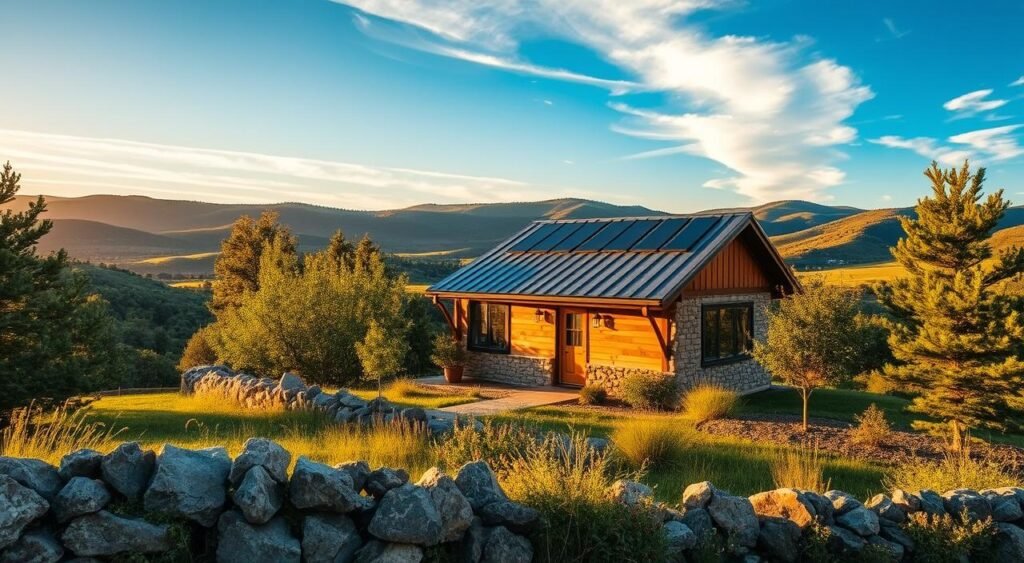
Discussing materials that maintain your small house exterior design in top condition, regardless of weather. Each area faces unique challenges—salt, snow, or intense sun. Your selections must balance aesthetics with protection. Here’s how to select the ideal materials:
Coastal Considerations for Saltwater Exposure
Salt can damage regular wood. Opt for fiber cement siding, which is salt-resistant and won’t rot. Vinyl trim with baked-on finishes and metal roofs with Kynar coatings also resist corrosion. Remember, use hurricane-rated impact glass on windows to prevent shattering in strong winds.
- Impact-resistant shingles (Class 4 rating) for roofs
- Stainless steel hardware to prevent rust
- Regular power-washing with mild acid solutions to remove salt buildup
Desert-Friendly Exteriors That Beat the Heat
The desert sun demands cool materials. Light-colored metal roofs reflect UV rays, instantly cooling indoor spaces. Stucco with titanium dioxide additives keeps mold at bay in humid environments. Thermal-mass materials like stone or ICF walls absorb heat by day and release it at night, reducing energy costs.
Pro tip: Install double-pane windows with low-emissivity coatings to block infrared rays. For foundations, use pressure-treated lumber or concrete block to resist extreme temperature expansion.
Northern Solutions for Snow and Ice Challenges
Heavy snow requires robust structures. Metal roofs shed ice faster than shingles, thanks to their slipperiness and light weight. ICF walls offer 10x more wind resistance than wood. For roofs, employ 30-lb felt underlayment to prevent ice dams. Don’t overlook garage floors: seal thresholds with polyurethane to block meltwater.
“ICF walls aren’t just safe—they’re stylish. Pair them with board-and-batten siding for a rustic yet tough look.”
Every material choice enhances curb appeal while safeguarding your investment. Whether near the coast or in the Rockies, the right selections ensure your compact house exterior ideas are both resilient and eye-catching.
Efficient Small House Outdoor Space: Patios, Decks and Gardens
“Your small backyard can function like a multi-room suite with the right design!”
Transform your yard into an expansive outdoor living area. Compact house exterior ideas, like “outdoor rooms,” create the illusion of space. Patios with built-in seating serve as dining areas, while vertical gardens add greenery without taking up space. Let’s explore my top strategies for making the most of tight spaces.
- Start with a focal point: A fire pit or dining set creates instant gathering zones.
- Go vertical: Use trellises or hanging planters to add layers without clutter.
- Choose multifunctional furniture: Foldable tables, nesting chairs, and storage benches hide away when not in use.
- Anchor with patterns: Light gray pavers or repeating plants create cohesion—no empty spots to feel cramped.
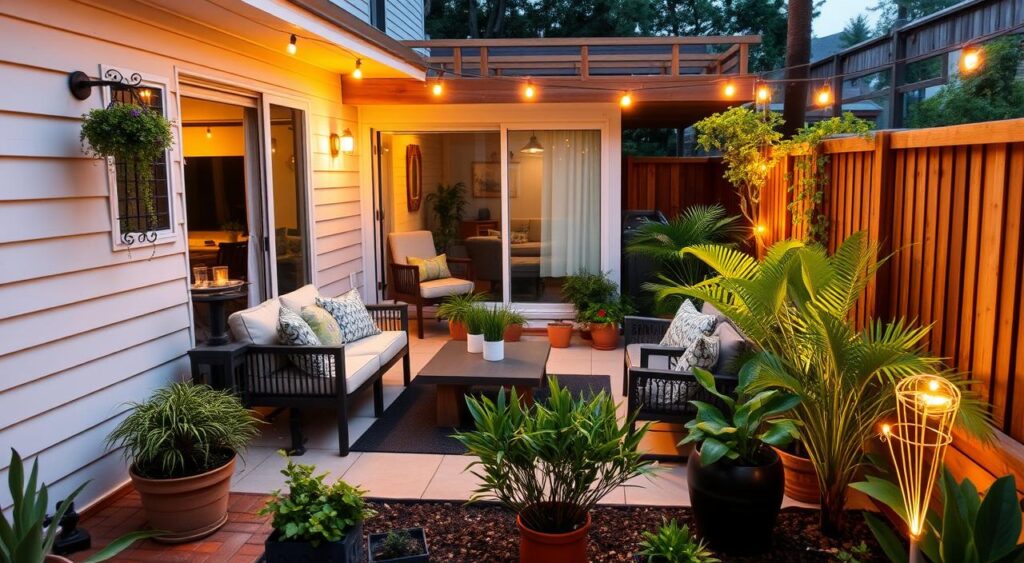
Start with budget-friendly upgrades like gravel pathways or DIY pallet planters. Even small investments, like a $300 fire pit or a $50 outdoor rug, can define zones. Remember, pairing a rectangular rug with symmetrical seating makes spaces feel intentional.
Homeowners have transformed narrow side yards into herb gardens or cozy dining nooks. The secret? Focus on your favorite activities first. Whether it’s a morning coffee nook or an evening firelight chat, every dollar spent on smart design adds value. Patios alone can enhance your home’s appeal, all within a $2,000–$15,000 budget.
Compact house exterior ideas don’t need a big budget; they just require clever planning. What’s your dream spot to unwind? Let’s turn that corner of your yard into your favorite room. 🌿
Blending Indoor and Outdoor Living in Compact Homes
Imagine stepping from your living room straight onto a patio without missing a beat—that’s the magic of connecting your efficient small house outdoor space with interior design. When you merge these areas, even the tiniest home feels expansive. Let’s explore how smart design choices turn corners into opportunities.
“When you blur the boundary between inside and outside, your small home can feel twice as large!”

Start with Windows and Doors That Open Worlds. Full-height sliders, like those in the Glass Wall House (San Mateo, California), let light flood in while disappearing when open. French doors or accordion-style systems create instant transitions. Even a small budget? Opt for large picture windows paired with lightweight screens—think the angular facade of the Portuguese lime mortar home.
Next, Hybrid Spaces That Do Double Duty. A covered porch in Seattle, like the courtyard design, becomes a dining area by day and a star-gazing spot at night. Use modular furniture to shift layouts. The Venice Beach compound’s poolside lounge? It’s both a kitchen extension and an outdoor room.
- Use sliding panels (like LA’s Blue Sail house) to instantly expand spaces
- Install motorized shades for weather flexibility
- Choose lightweight materials for easy rearrangement
Lastly, Visual Tricks That Unify Spaces. Carry flooring outdoors—like the Hertsliya home’s deck—so transitions feel seamless. Match exterior colors to interior walls (e.g., the Axiom Desert House’s neutral tones). Even potted plants inside that mirror outdoor greenery trick the eye into seeing more space.
These strategies turn your small house exterior design into a seamless extension of home. Ready to erase those lines between inside and out? Start with one bold window upgrade or a modular seating set. Your space will breathe new life!
Before and After: Small House Exterior Design Transformations
Seeing is believing when it comes to small house exterior design. These real-life transformations show that even with modest budgets and DIY efforts, stunning results are possible. Let’s explore three inspiring stories of homeowners who transformed their homes from “meh” to “Wow!”
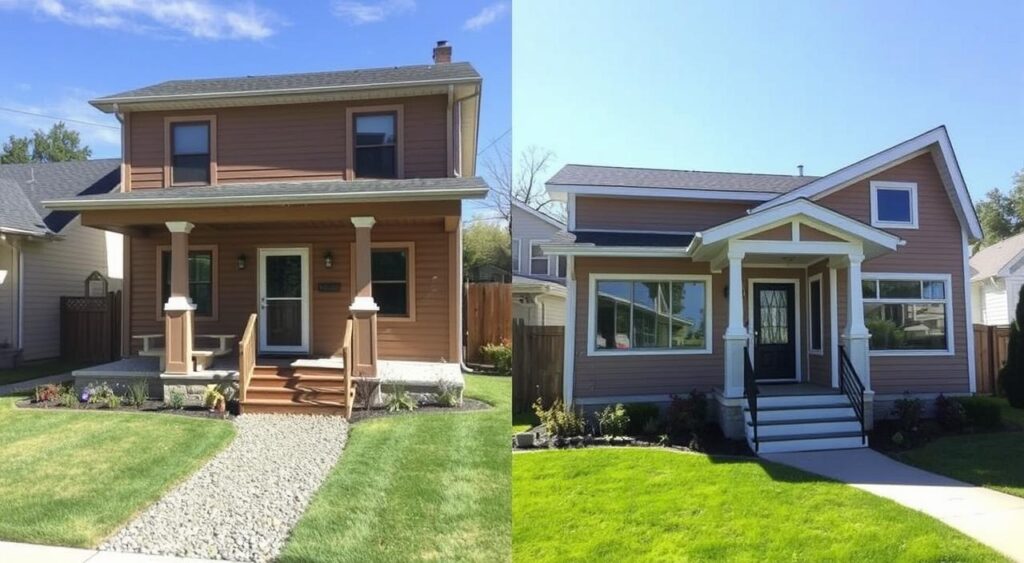
“After painting and adding boxwoods borders, my house felt like a completely different home.” — Sarah T., Ohio homeowner
Case Study 1: The 1925 Bungalow
- Problem: Rotted wood, outdated windows, and neglected landscaping
- Solution: Fresh paint, cedar siding, and a budget small house landscaping plan with hydrangeas and boxwoods
- Result: Curb appeal boosted 40% — and neighbors now stop to admire it!
Case Study 2: Midcentury Modern Makeover
- Key moves: White facade + black shutters for contrast
- Landscaping hack: Pachysandra groundcover instead of costly plants
- Outcome: Property value increased by $18K in just 18 months
Case Study 3: Coastal Cottage Revival
- Challenge: Dull gray brick + unkempt front yard
- Fix: Painted with Benjamin Moore’s Pale Oak, added seafoam green shutters, and a hydrangea-lined walkway
- ROI: Sold 20% above market value after the refresh
Every project here spent under $10K but delivered big results. Remember, a fresh coat of paint, smart landscaping choices, and strategic architectural accents can completely reinvent your home’s persona. Need proof? Look at how those squared-off columns and flared awnings turned one 1950s ranch into a modern farmhouse hit!
Conclusion: Creating Your Small House Exterior Design Plan
Your small house exterior design doesn’t have to be a compromise. By embracing modern small house facade principles, you can achieve both style and functionality. Begin by analyzing your home’s current layout. Note where sunlight hits, where plants thrive, and where storage can hide unsightly areas.
Even small updates, like rearranging potted plants or updating facade accents, can greatly enhance curb appeal. Share your progress online—tag us or post before/after shots! Seeing your space evolve will remind you that every detail counts. Let your design tell a story about who you are, staying true to modern principles. Your dream facade is waiting for your creativity to bring it to life. Ready to turn that blank wall into a conversation starter? The tools and ideas are yours to use—now it’s time to make it real.
